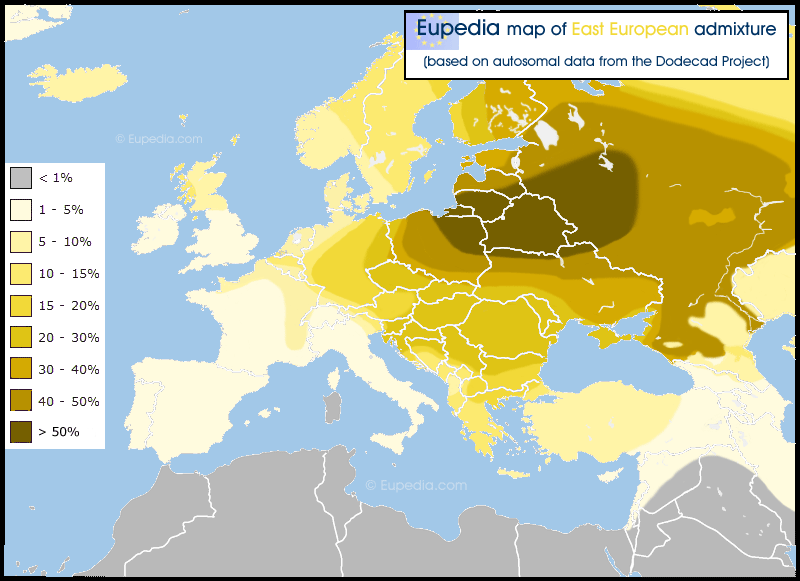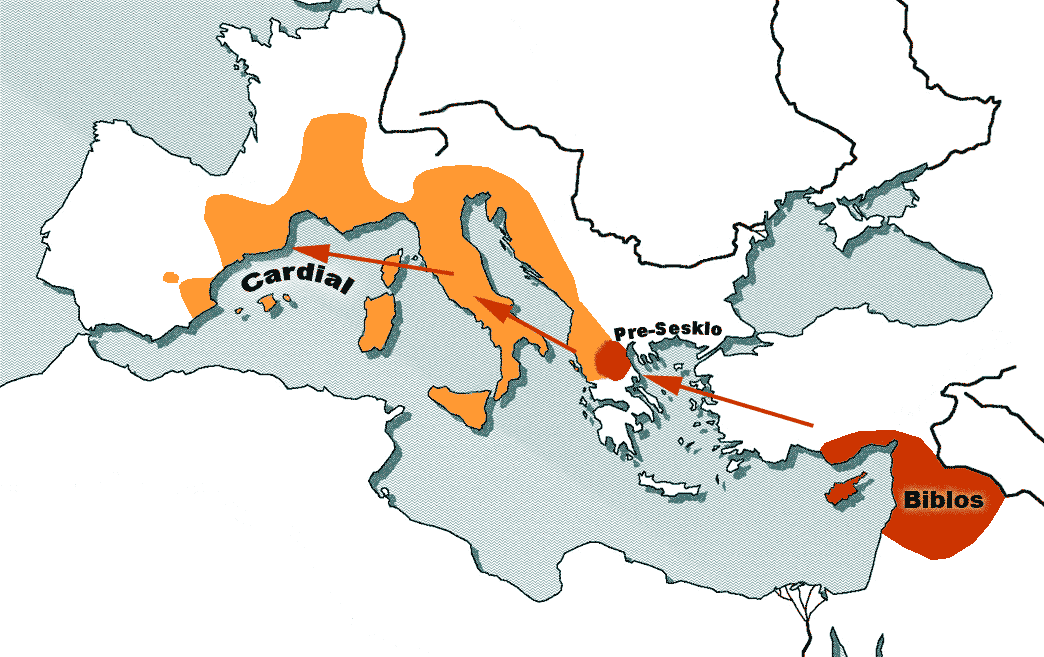as it turns out after looking at 23AndMe, you have always been the one with the dreams...maybe with a good purpose, but still useless..one who dreams............... a fantasy statistic
Install the app
How to install the app on iOS
Follow along with the video below to see how to install our site as a web app on your home screen.

Note: This feature currently requires accessing the site using the built-in Safari browser.
You are using an out of date browser. It may not display this or other websites correctly.
You should upgrade or use an alternative browser.
You should upgrade or use an alternative browser.
Dacian Language
- Thread starter Dagne
- Start date
have albanians been tested for EEF, WHG and ANE numbers?
the Ralph and Coop paper states Albanians arrived in the balkans around 500AD
You misunderstood the data.
The highest levels of IBD sharing are found in the Albanian-speaking individuals (from Albania and Kosovo), an increase in common ancestry deriving from the last 1,500 years. This suggests that a reasonable proportion of the ancestors of modern-day Albanian speakers (at least those represented in POPRES) are drawn from a relatively small, cohesive population that has persisted for at least the last 1,500 years. These individuals share similar but slightly higher numbers of common ancestors with nearby populations than do individuals in other parts of Europe (see Figure S3), implying that these Albanian speakers have not been a particularly isolated population so much as a small one. Furthermore, our Greek and Macedonian samples share much higher numbers of common ancestors with Albanian speakers than with other neighbors, possibly a result of historical migrations, or else perhaps smaller effects of the Slavic expansion in these populations. It is also interesting to note that the sampled Italians share nearly as much IBD with Albanian speakers as with each other. The Albanian language is a Indo-European language without other close relatives [53] that persisted through periods when neighboring languages were strongly influenced by Latin or Greek, suggesting an intriguing link between linguistic and genealogical history in this case.
By the way, this is what they said in their AMA:
http://www.reddit.com/r/askscience/...ce_ama_we_are_the_authors_of_a_recent/c9zkgq0So in general geographic distance is the best predictor of genetic similarity in Europe, so language doesn't seems to have a huge effect as a barrier. See also Novembre et al on this,http://www.nature.com/nature/journal/v456/n7218/full/nature07331.htmlThe Hungarians, in our sample, do not particularly stand out as usual. We see that they share the signal of am increase in recent ancestry with other Eastern European countries, that might date to the migration period.
One linguistic group that do stand out in our analysis is the Albanian speaking sample in the POPRES data. They seem to show a higher degree of relatedness to each other than is typical elsewhere in Europe. We are not totally sure what this means, but we think it indicates that they've been a somewhat small reasonably cohesive populations for the past 2000 years.
They did not say Albanians came in the Balkans in c. 500 AD, but that Albanians stood together despite everything that happened in the Balkans.
FBS
Regular Member
- Messages
- 408
- Reaction score
- 89
- Points
- 28
- Location
- Prishtinë, Kosovo
- Ethnic group
- Kosovar-Albanian
- Y-DNA haplogroup
- E1b1b1a2*
- mtDNA haplogroup
- J1c3
this is mine (from 23andme):
92.3%
Balkan
1.2%
Italian
4.3%
Broadly Southern European
0.5%
Scandinavian
0.1%
Broadly Northern European
1.4%
Broadly European
0.2%
Unassigned
This is another Kosovar, my very distant relative according to 23andme
91.9%
Balkan
0.2%
Italian
3.7%
Broadly Southern European
2.2%
Eastern European
0.1%
Ashkenazi
1.8%
Broadly European
92.3%
Balkan
1.2%
Italian
4.3%
Broadly Southern European
0.5%
Scandinavian
0.1%
Broadly Northern European
1.4%
Broadly European
0.2%
Unassigned
This is another Kosovar, my very distant relative according to 23andme
91.9%
Balkan
0.2%
Italian
3.7%
Broadly Southern European
2.2%
Eastern European
0.1%
Ashkenazi
1.8%
Broadly European
Sile
Banned
- Messages
- 5,110
- Reaction score
- 582
- Points
- 0
- Location
- Australia
- Ethnic group
- North Alpine Italian
- Y-DNA haplogroup
- T1a2 -Z19945..Jura
- mtDNA haplogroup
- H95a1 ..Pannoni
You misunderstood the data.
By the way, this is what they said in their AMA:
http://www.reddit.com/r/askscience/...ce_ama_we_are_the_authors_of_a_recent/c9zkgq0
They did not say Albanians came in the Balkans in c. 500 AD, but that Albanians stood together despite everything that happened in the Balkans.
fine
have albanians been tested for EEF, WHG and ANE numbers?
Ike
Regular Member
- Messages
- 1,128
- Reaction score
- 93
- Points
- 0
They did not say Albanians came in the Balkans in c. 500 AD, but that Albanians stood together despite everything that happened in the Balkans.
No, they did not say that either. They don't even know if that small population was Albanian, disregarding the fact how long has it been in Balkans.
mihaitzateo
Regular Member
- Messages
- 943
- Reaction score
- 98
- Points
- 0
- Location
- Bucharest
- Ethnic group
- Romanian
- Y-DNA haplogroup
- proly R1B
Try to use K36 from Eurogenes which is much more relevant.this is mine (from 23andme):
92.3%
Balkan
1.2%
Italian
4.3%
Broadly Southern European
0.5%
Scandinavian
0.1%
Broadly Northern European
1.4%
Broadly European
0.2%
Unassigned
This is another Kosovar, my very distant relative according to 23andme
91.9%
Balkan
0.2%
Italian
3.7%
Broadly Southern European
2.2%
Eastern European
0.1%
Ashkenazi
1.8%
Broadly European
Here is a thread where 2 Albanians posted results:
http://www.eupedia.com/forum/threads/28467-K36-from-Eurogenes
Both have way too much Iberian and West Med admixture,for a native Eastern European (they score about 20% or more Iberian + West Med). Also is weird that they got about 4-5% North Sea admixture.
Of course Albanians don't have native Eastern European Admixture, because there isn't much the Dinaric Alps:Try to use K36 from Eurogenes which is much more relevant.
Here is a thread where 2 Albanians posted results:
http://www.eupedia.com/forum/threads/28467-K36-from-Eurogenes
Both have way too much Iberian and West Med admixture,for a native Eastern European (they score about 20% or more Iberian + West Med). Also is weird that they got about 4-5% North Sea admixture.

See? It doesn't even originate in the Balkans. look at the darkest part. It originates in Belarus/Lithuania/Russia mostly a little bit of Poland/Ukraine/Latvia too.
No, they did not say that either. They don't even know if that small population was Albanian, disregarding the fact how long has it been in Balkans.
Yes they did, that's the meaning of cohesive: closely united. Of course they know that small population was Albanian, because Albanians were actually tested. By them. Also, let's not disregard time, they mention that too:
The Albanian language is a Indo-European language without other close relatives that persisted through periods when neighboring languages were strongly influenced by Latin or Greek
Albanian was spoken next to Latin and Greek and it survived when all the rest didn't. That's the 'persisted through periods' part along with 'neighouring languages' being influenced by Latin and Greek.
Should I repeat now? Albanians stood together (cohesive) despite what happaned in the Balkans (Latin and Greek influence).
Ike
Regular Member
- Messages
- 1,128
- Reaction score
- 93
- Points
- 0
We have absolutely no proof that population was Albanian 2000 years ago.Yes they did, that's the meaning of cohesive: closely united. Of course they know that small population was Albanian, because Albanians were actually tested. By them.
Or it was Greek, influenced by Albanian? Which would be more in touch with the evidence pointing that Greek were already there, and that Albanians probably arrived in the last 1000-2000 years.Albanian was spoken next to Latin and Greek and it survived when all the rest didn't. That's the 'persisted through periods' part along with 'neighouring languages' being influenced by Latin and Greek.
That could have also been Ancient Macedonian, Phrygian, or any of 100 extinct languages from that area. Still no proof of connection with Albanian ethnos of today.Should I repeat now? Albanians stood together (cohesive) despite what happaned in the Balkans (Latin and Greek influence).
As you have quoted in #282 , we can make a calculation:
"...that these Albanian speakers have not been a particularly isolated population so much as a small one"
Family of 2 having 4 surviving kids, with a 25 years distance between two generation, gives 2^10=1000 decessors after 10 generations which is 250 years.
Give it another 250 years, and you have a 1000x more which is a million. That's what you have after just 500 years. So, claiming anything, and basing it on HG maps of today is inappropriate.
In the lack of better evidence, we can also assume that words of unknown origin in Albanian language are remnants from Levant, and that Albanian language didn't exist. Of course, it's not worth much without actual evidence.You understand, I can go on like this for 100 more posts? Your assumption that "Albanians stood together despite everything that happened in the Balkans" is just as good as any of those 100...
"The earliest Impressed Ware sites, dating to 6400-6200 BC, are in Epirus and Corfu. Settlements then appear in Albania and Dalmatia on the eastern Adriatic coast dating to between 6100 and 5900 BC. The earliest date in Italy comes from Coppa Nevigata on the Adriatic coast of southern Italy, perhaps as early as 6000 cal B.C. Also during Su Carroppu civilization in Sardinia, already in its early stages (low strata into Su Coloru cave, c. 6000 BC) early examples of cardial pottery appear.[6] Northward and westward all secure radiocarbon dates are identical to those for Iberia c. 5500 cal B.C., which indicates a rapid spread of Cardial and related cultures: 2,000 km from the gulf of Genoa to the estuary of the Mondego in probably no more than 100–200 years. This suggests a seafaring expansion by planting colonies along the coast."
http://dispatchesfromturtleisland.blogspot.com/2013/03/the-phoenicians.html

mihaitzateo
Regular Member
- Messages
- 943
- Reaction score
- 98
- Points
- 0
- Location
- Bucharest
- Ethnic group
- Romanian
- Y-DNA haplogroup
- proly R1B
Of course Albanians don't have native Eastern European Admixture, because there isn't much the Dinaric Alps:

See? It doesn't even originate in the Balkans. look at the darkest part. It originates in Belarus/Lithuania/Russia mostly a little bit of Poland/Ukraine/Latvia too.
Yes they did, that's the meaning of cohesive: closely united. Of course they know that small population was Albanian, because Albanians were actually tested. By them. Also, let's not disregard time, they mention that too:
Albanian was spoken next to Latin and Greek and it survived when all the rest didn't. That's the 'persisted through periods' part along with 'neighouring languages' being influenced by Latin and Greek.
Should I repeat now? Albanians stood together (cohesive) despite what happaned in the Balkans (Latin and Greek influence).
Albanians got Iberian admixture,French Admixture and even Basque admixture.Also North Atlantic admixture.
Iberian admixture of around 12% in SE Europe,how is that possible?
And for your info Eastern European admixture was brought not only by Slavs,but also by other migrators that came from North Europe.
This thread has been viewed 206312 times.
